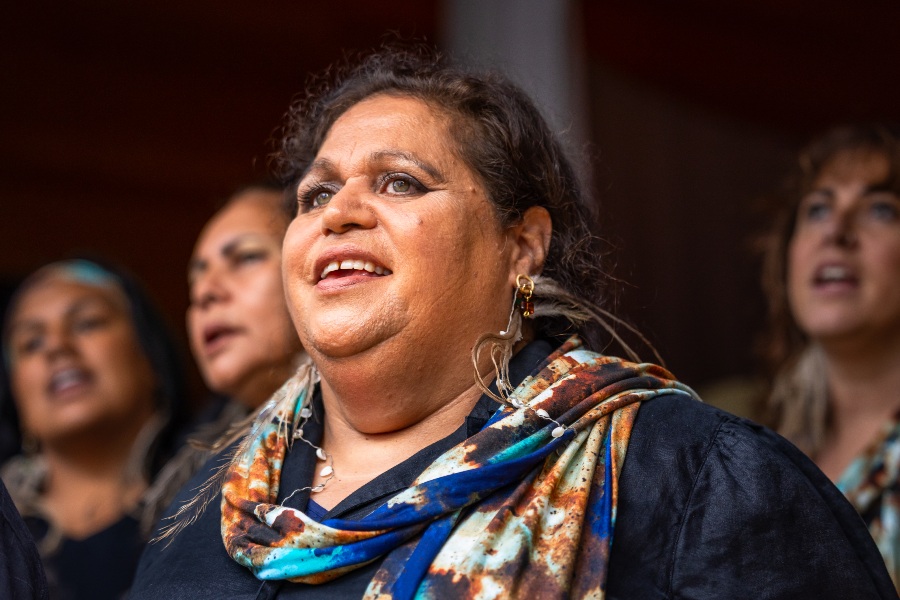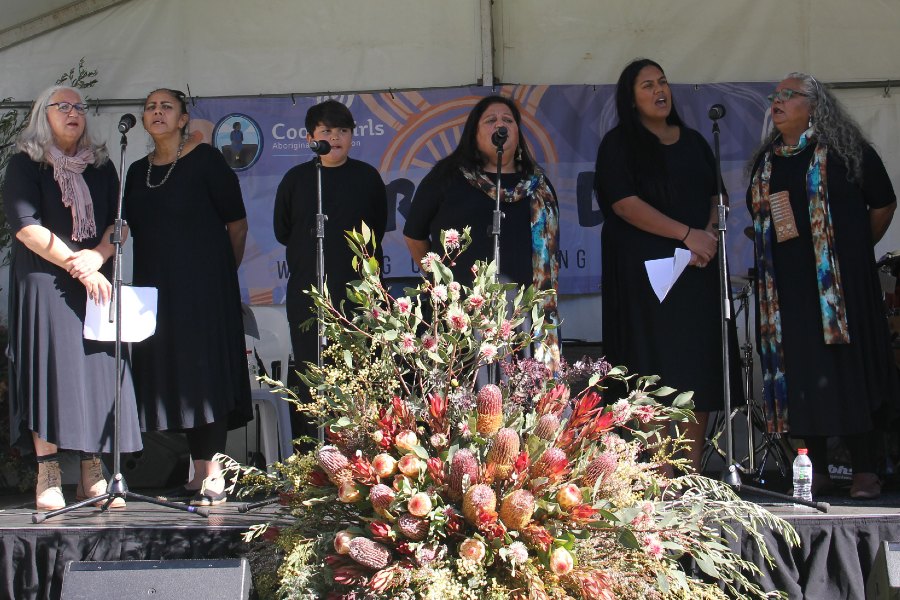An intergenerational Yuin choir is helping to revitalise and renew the Dhurga language – an act that would have seen them thrown in jail only a generation before.
Walbunga/Ngarigo artist Cheryl Davison remembers being an eight-year-old girl, watching a group of Northern Territory Aboriginal dancers perform at the local Warrawong shopping centre. She and her cousins from the NSW South Coast looked on in awe: ‘I don’t know who they was, but there was a big mob of them, all singing and dancing and talking in language.’
She recalls going home and telling her father and aunty about these Blackfullas she’d seen dancing and speaking in a strange language.
My dad told me that I too was Blackfulla and that our people used to talk like that. I said, “Why didn’t you teach us?” I felt a bit upset that we hadn’t learned our language.
Many decades later Cheryl leads Djinama Yilaga, a renowned choir made up of South Coast Yuin people, helping to revitalise her ancestors’ language, Dhurga, through song.
Before colonisation of their land, Yuin people were multilingual, speaking and understanding languages of neighbouring and visiting groups. Dhurga was the mother tongue of the Walbunga people of the Broulee region and the Brindja Yuin people of Moruya. It was spoken and understood by many within the 13 tribes of the Yuin Nation.
The arrival of Europeans into the South Coast region of NSW changed everything and speaking Dhurga language became a punishable offense for Yuin.
Decades after hearing those NT dancers speaking language, Cheryl discovered that her grandmother and greatgrandmother were both fluent Dhurga speakers but used to usher the kids out of the room when they spoke.
‘The police turned up at Nan’s doorstep and said, “You teach them kids anymore that language and we’re going to chuck you in jail,”’ said Cheryl.
So, there’s always been that hurt and feeling very robbed, you know of something so beautiful that we missed out on as a community.
The Djinama Yilaga choir started in 2018 when Cheryl was working at Four Winds Festival, an annual music and culture event set in the bush near Bermagui on the South Coast.
Cheryl, with no history or background in music, organised for Lou Bennet from the iconic band Tiddas to deliver a unique workshop for the community, which led to the idea of forming a choir.
‘Because I thought forming a choir would be easy!’, she said. ‘But it wasn’t easy.’

It was difficult to keep the women engaged in choir practice and they would often drop out. Cheryl explains that in the beginning the choir only sang songs that everyone knew. ‘We were just singing songs, hymns that we knew, and songs that we liked. It was hard because a lot of the women in our community are embarrassed and shy and many left after just a short time.’
I just had to think outside of the box; what’s something that would bring community in?
Then one day during rehearsals the women started singing Christine Anu’s and Tiddas’ songs in language. The women sang these songs in languages that they did not understand and that did not belong to them. Cheryl had an idea!
‘I thought if we can do that, if we can sing those words and memorise that language, surely we can learn our own,’ she remembers. ‘So that’s where it all started. Let’s have a crack at our own language.’
From that moment on opportunities started opening up for the choir. It was singing in their own language that was the catalyst for people to become more enthusiastic.
‘When we learn our language from this Country, it gives us such a deeper connection. We don’t feel like we are singing to audiences; it’s like we’re singing for Country more than anything,’ said Cheryl. ‘We want to sound like our ancestors.’

The first few songs they wrote were created from Dhurga words, but these songs suffered from a lack of grammar and syntax. Then in 2020 a Dhurga language dictionary was produced by local Yuin siblings Trish Ellis, Kerry Boyenga and Wayne Donovan and published by the Australian Institute for Aboriginal and Torres Strait Islander Studies.
And now Moruya and Ulladulla TAFE are both offering Certificates in Dhurga language.
TAFE students agree with Cheryl that the language courses have done a lot to bring the community together. Ulladulla student Gayle Nolan told TAFE that she loves talking in Dhurga. ‘It’s something we’ve not been able to do until now. It’s an amazing feeling for us to be able to hear our language in song, poetry, and stories.’
In this International Decade of Indigenous Languages, the Dhurga language of the NSW South Coast is being revitalised. Across the continent the members of Djinama Yilaga are proudly highlighting their ancestral tongue and recently the choir toured Poland to present their Yuin culture to Europe.
‘We’re singing our Country. Our ancestors are around us all the time. Yeah, we know that. We believe that. We feel that,’ declares Cheryl Davison.
This article is from the 50th edition of Reconciliation News magazine. Read the rest of the issue.


